-

人教版新目标初中英语九年级下册We’re trying to save the manatees教案2篇
本单元主要围绕着有关濒临灭绝的动物这一话题,学习了应该怎样保护我们的环境,以及就某一问题展开辩论。目标提示语言目标能够运用所学知识,就某一问题展开辩论。认知目标1、复习一些语法:现在进行时、一般现在时、用used to 表示一般过去时、现在完成时、一般过去时的被动语态。2、学会表达同意和不同意。3、学会以下基本句型:We’re trying to save the manatees.Manatees eat about 100 pounds of food a day.There used to be a lot of manatees.In 1972,it was discovered that they were endangered.Some of the swamps have become polluted.情感目标了解一些濒临灭绝的动物的生活习性和濒临灭绝的原因,教育学生应该如何保护环境。教学提示充分利用多媒体等教学设备,创设与本课话题相关的情境,如各种不同种类的动物、动物园以及有关环境的画画等等。围绕着本单元的教学目标,设计一些贴近学生实际的教学任务,如让学生谈论自己最喜欢的动物,如何拯救濒危动物,如何保护环境等等。让学生根据所学知识,就动物园是否对动物有利以及其他的话题进行辩论。

人教版新目标初中英语九年级下册You’re supposed to shake hands教案
教学目标:1. 掌握本单元一些重点词汇的写法和用法。2. 学会自如谈论餐桌礼仪。Step 1 RevisionAsk some students to retell the customs at the table in France in the passage in 3a.Step 2 Self checkPart 1. Fill in each bland with the correct word given. Students do the exercises by themselves at first. Then check the answers. Ask the students to comprehend the sentences and help them point out uses of some words, like “arrive (at / in) sw., spend time / money on sth , spend time / money (in) doing sth.”Part 2. Read about Fan Ling’s experience in a western restaurant. Understand the passage. Point out some key points in the passage.1. be / get used to doing sth. 习惯做某事2. begin with = start with 以….开头3. crowd v. 挤满,塞满 the crowd 人群 crowded adj. 拥挤的Then students discuss about how she would solve her problem. Ask some to share their stories with others.Part 3. Complete the crossword by looking at the sentences on the left. Then check the answers.
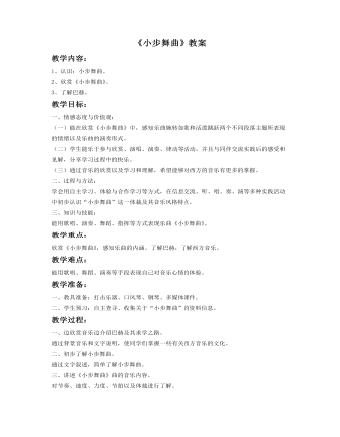
《小步舞曲教案》教案
教学过程:一、边欣赏音乐边介绍巴赫及其求学之路。通过背景音乐和文字说明,使同学们掌握一些有关西方音乐的文化。二、初步了解小步舞曲。通过文字叙述,简单了解小步舞曲。三、讲述《小步舞曲》曲的音乐内容。对节奏、速度、力度、节拍以及体裁进行了解。四、结合谱例分段学习《小步舞曲》。1、学习乐曲A’段。说明:依据乐曲创作背景,合理创设“舞会”情景,从而有效激发学生学习兴趣,用舞蹈表现手段演绎此乐段,发展了学生的舞蹈表演能力,享受到美的愉悦。2、学习乐曲B段。说明:利用形象、直观的图式辅助以及一系列贴近学生思维逻辑的问答讨论,激发学生的思考,帮助学生准确把握乐段情绪,并能用指挥、伴奏等方式表现该乐段。3、完整欣赏《小步舞曲》。说明:学生在完整欣赏乐曲时能够巩固乐曲主题的记忆,并且听辨、感受乐曲两个不同主题情绪,培养学生独立的音乐感受和见解。五、视频欣赏。说明:通过视屏欣赏,使同学们以一个更直观的郊区去理解和学习作品,并使同学对作品有更深刻的记忆。引起学生共鸣,领悟音乐的美感,愉悦身心,获取乐趣,从而激起学习的情趣。
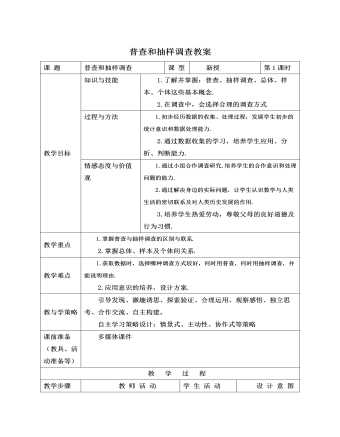
北师大初中七年级数学上册普查和抽样调查教案2
1.举例说明什么时候用普查的方式获得数据较好,什么时候用抽样调查的方式获得数据较好?2、下列调查中分别采用了那些调查方式?⑴为了了解你们班同学的身高,对全班同学进行调查.⑵为了了解你们学校学生对新教材的喜好情况,对所有学号是5的倍数的同学进行调查。3、说明在以下问题中,总体、个体、样本各指什么?⑴为了考察一个学校的学生参加课外体育活动的情况,调查了其中20名学生每天参加课外体育活动的时间.⑵为了了解一批电池的寿命,从中抽取10只进行实验。⑶为了考察某公园一年中每天进园的人数,在其中的30天里对进园的人数进行了统计。通过本节课的学习,同学们有什么收获和疑问?1、基本概念:⑴.调查、普查、抽样调查.⑵.总体、个体、样本.2、何时采用普查、何时采用抽样调查,各有什么优缺点?
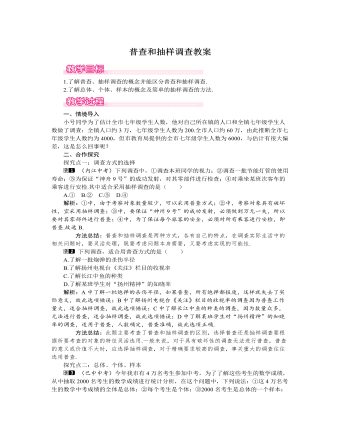
北师大初中七年级数学上册普查和抽样调查教案1
判断下面抽样调查选取样本的方法是否合适:(1)检查某啤酒厂即将出厂的啤酒质量情况,先随机抽取若干箱(捆),再在抽取的每箱(捆)中,随机抽取1~2瓶检查;(2)通过网上问卷调查方式,了解百姓对央视春节晚会的评价;(3)调查某市中小学生学习负担的状况,在该市每所小学的每个班级选取一名学生,进行问卷调查;(4)教育部为了调查中小学乱收费情况,调查了某市所有中小学生.解析:本题应看样本是否为简单随机样本,是否具有代表性.解:(1)合适,这是一种随机抽样的方法,样本为简单随机样本.(2)不合适,我国农村人口众多,多数农民是不上网的,所以调查的对象在总体中不具有代表性.(3)不合适,选取的样本中个体太少.(4)不合适,样本虽然足够大,但遗漏了其他城市里的这些群体,应在全国范围内分层选取样本,除了上述原因外,每班的学生全部作为样本是没有必要的.
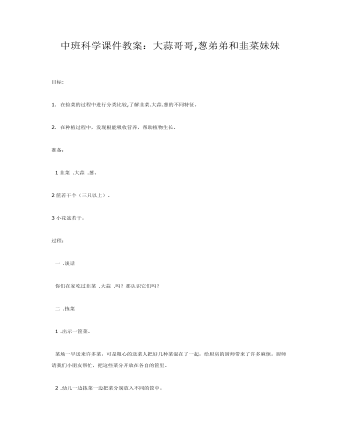
中班科学课件教案:大蒜哥哥,葱弟弟和韭菜妹妹
1. 在捡菜的过程中进行分类比较,了解韭菜.大蒜.葱的不同特征。2. 在种植过程中,发现根能吸收营养,帮助植物生长。准备: 1韭菜 .大蒜 .葱。2筐若干个(三只以上)。3小花盆若干。
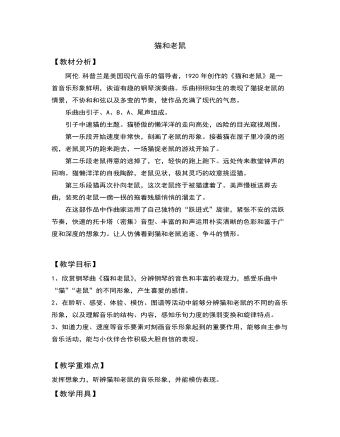
二年级音乐欣赏猫和老鼠教案教学设计
阿伦.科普兰是美国现代音乐的倡导者,1920年创作的《猫和老鼠》是一首音乐形象鲜明,诙谐有趣的钢琴演奏曲。乐曲栩栩如生的表现了猫捉老鼠的情景,不协和和弦以及多变的节奏,使作品充满了现代的气息。乐曲由引子、A、B、A、尾声组成。引子中速猫的主题。猫骄傲的懒洋洋的走向高处,凶险的目光窥视周围。第一乐段开始速度非常快,刻画了老鼠的形象。接着猫在屋子里冷漠的巡视,老鼠灵巧的跑来跑去,一场猫捉老鼠的游戏开始了。第二乐段老鼠得意的逃掉了,它,轻快的跑上跑下。远处传来教堂钟声的回响。猫懒洋洋的自我陶醉,老鼠见状,极其灵巧的故意挑逗猫。第三乐段猫再次扑向老鼠,这次老鼠终于被猫逮着了。美声慢板送葬去曲,装死的老鼠一瘸一拐的拖着残腿悄悄的溜走了。在这部作品中作曲家运用了自己独特的“跃进式”旋律,紧张不安的活跃节奏,快速的托卡塔(密集)音型、丰富的和声运用朴实清晰的色彩和富于广度和深度的想象力。让人仿佛看到猫和老鼠追逐、争斗的情形。
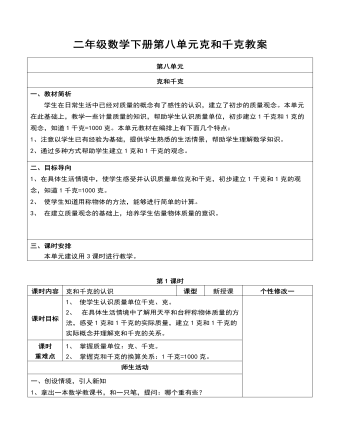
二年级数学下册第八单元克和千克教案
1、拿出一本数学教课书,和一只笔,提问:哪个重有些?2、肯定学生的回答,并让学生“掂一掂”,然后让学生说说有什么样的感觉。3、从刚才的实践得出结论:物体有轻有重。板书课题。二、观察、操作领悟新知1、出示主题挂图,物体的轻重的计量。观察主题挂图。(1、)请同学们观察一下,这幅图画的是什么?(2、)这幅图中的小朋友和阿姨在说什么?(3、)前几天,老师让大家广泛收集、调查我们日常生活中常见物品的质量,我们现在来交流以下好吗?表示物品有多重,可以用克和千克单位来表示。(4、)在学生说的同时,老师拿出有准备的东西展示。
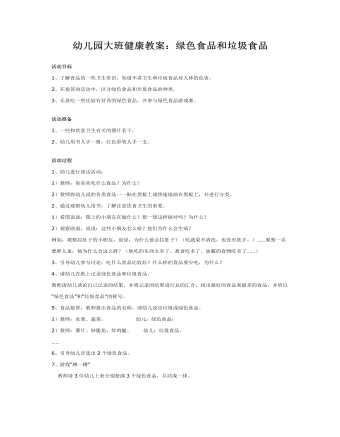
幼儿园大班健康教案:绿色食品和垃圾食品
活动准备 1、一些和饮食卫生有关的图片若干。 2、幼儿用书人手一册,红色彩笔人手一支。活动过程 1、幼儿进行谈话活动: 1)教师:你喜欢吃什么食品?为什么? 2)教师将幼儿说的各类食品一一贴在黑板上或快速地画在黑板上,并进行分类。 2、通过观察幼儿用书,了解注意饮食卫生的重要。 1)看图说说:图上的小朋友在做什么?想一想这样做对吗?为什么? 2)观察画面,说说:这些小朋友怎么啦?他们为什么会生病? 例如:观察拉肚子的小朋友,说说:为什么他会拉肚子?(吃蔬果不清洗,也没有洗手。)……观察一名肥胖儿童:他为什么会这么胖?(他吃的东西太多了、甜食吃多了、油腻的食物吃多了……)

大班社会教案:我和爷爷奶奶同过节(重阳)
二、活动目的: 1、培养幼儿关心老人的情感。 2、体验与老人同过节的快乐。 1、增进艺术表现能力,学习运用学过的技能,合理地安排画面,画出爷爷奶奶的形象。 三、活动准备: 1、请爷爷奶奶来园参加活动。 2、幼儿自备自己制作的小礼物。 3、幼儿事先排练表演的节目。 4、纸笔幼儿人手各一份。
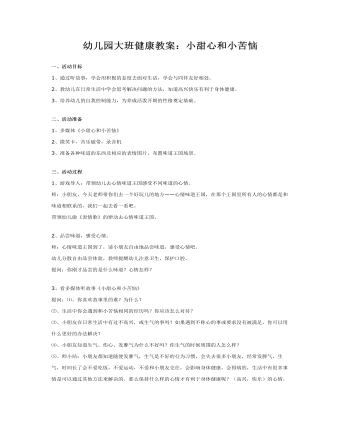
幼儿园大班健康教案:小甜心和小苦恼
二、活动准备 1、多媒体《小甜心和小苦恼》 2、微笑卡,音乐磁带,录音机 3、准备各种味道的东西及相应的表情图片,布置味道王国场景。三、活动过程 1、游戏导入:带领幼儿去心情味道王国感受不同味道的心情。 师:小朋友,今天老师带你们去一个好玩儿的地方——心情味道王国,在那个王国里所有人的心情都是和味道相联系的,我们一起去看一看吧。 带领幼儿做《表情歌》的律动去心情味道王国。2、品尝味道,感受心情。 师:心情味道王国到了,请小朋友自由地品尝味道,感受心情吧。 幼儿分散自由品尝体验,教师提醒幼儿注意卫生,保护口腔。 提问:你刚才品尝的是什么味道?心情怎样?
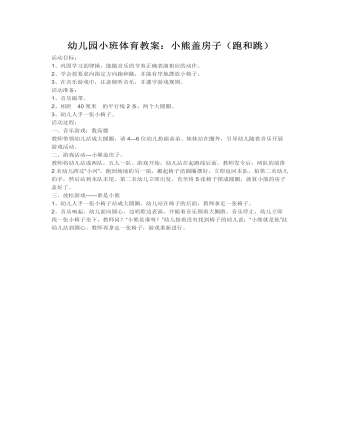
幼儿园小班体育教案:小熊盖房子(跑和跳)
2、学会按要求向指定方向跑和跳,并能有序地摆放小椅子。 3、在音乐游戏中,注意倾听音乐,并遵守游戏规则。 活动准备: 1、音乐磁带、 2、相距 40厘米 的平行线2条,两个大圆圈。 3、幼儿人手一张小椅子。 活动过程: 一、音乐游戏:数高楼 教师带领幼儿站成大圆圈,请4—6位幼儿扮演弟弟、妹妹站在圈外,引导幼儿随着音乐开展游戏活动。
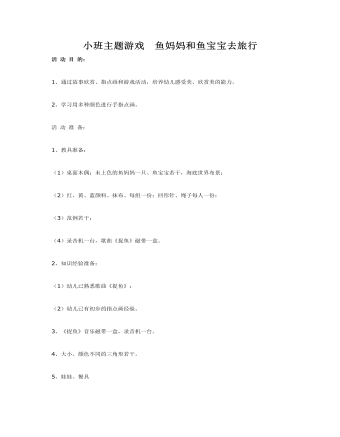
小班主题游戏 鱼妈妈和鱼宝宝去旅行课件教案
2、学习用多种颜色进行手指点画。活动准备:1、教具准备:(1)桌面木偶:未上色的鱼妈妈一只、鱼宝宝若干,海底世界布景;(2)红、黄、蓝颜料、抹布、每组一份;回形针、绳子每人一份;(3)范例若干;(4)录音机一台,歌曲《捉鱼》磁带一盒。2、知识经验准备:(1)幼儿已熟悉歌曲《捉鱼》;(2)幼儿已有初步的指点画经验。
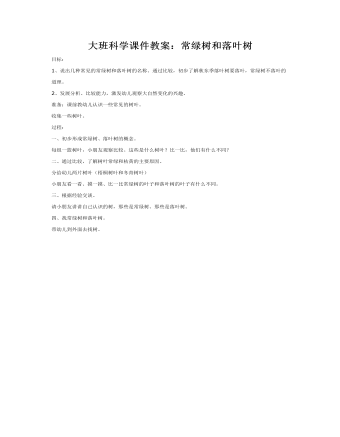
大班科学课件教案:常绿树和落叶树
2、发展分析、比较能力,激发幼儿观察大自然变化的兴趣。准备:课前教幼儿认识一些常见的树叶。收集一些树叶。过程:一、初步形成常绿树、落叶树的概念。每组一篮树叶,小朋友观察比较。这些是什么树叶?比一比,他们有什么不同?
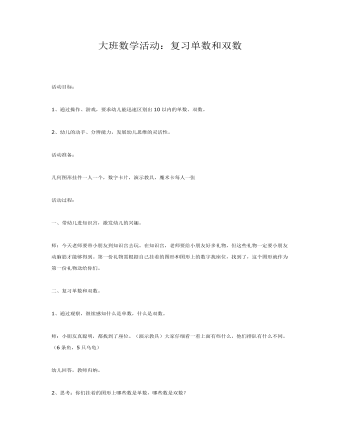
大班数学活动:复习单数和双数课件教案
2、幼儿的动手、分辨能力,发展幼儿思维的灵活性。活动准备:几何图形挂件一人一个,数字卡片,演示教具,魔术卡每人一张活动过程:一、带幼儿进知识宫,激发幼儿的兴趣。师:今天老师要带小朋友到知识宫去玩。在知识宫,老师要给小朋友好多礼物,但这些礼物一定要小朋友动脑筋才能够得到。第一份礼物需根据自己挂着的图形和图形上的数字找座位,找到了,这个图形就作为第一份礼物送给你们。
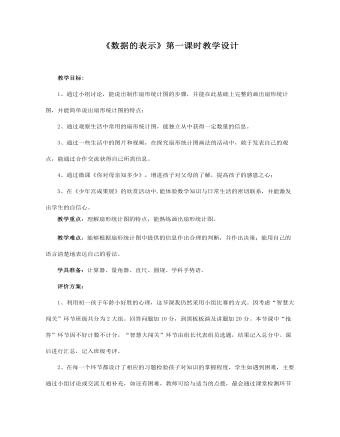
数据的收集与整理 3 数据的表示教案教学设计
创设情境,导入新课:你对母亲知多少师问1:我们5月份刚过了一个重要的节日,你知道是什么吗?----母亲节。师问2:那你知道妈妈的生日吗?(举手示意),每个妈妈都知道自己孩子的生日,请不知道的同学回家了解一下,多关心一下自己的父母。师问3:那你知道妈妈最爱吃的菜吗?你可以选择知道、不知道或者是没有爱吃的(拖动白板上相对应的表情符号)。请大家用不同的手势表示出来。我找3名同学统计各组的数据,写在黑板上(随机找3名学生数人数)。下面我来随机采访一下:你妈妈最喜欢吃的菜是什么?(教师随机采访,结合营养搭配和感恩教育)

中班主题课件教案:“我的朋友”的主题反思
主题目标: 能关注周围环境中的事物,初步了解并体验人与人、人与整个环境和谐相处的快乐感觉;能在成人帮助下逐步形成与他人共处的良好态度;学习并尝试与人交往的方式,促进社会交往能力的发展。 主题的开展: 本月以“我的朋友”为主题,围绕“朋友都有谁、快快乐乐来玩耍、友好相处是朋友、”三个方面的内容展开活动,环境方面突出的是我们有效的利用家长资源,带动幼儿及教师家长的兴趣。 俗话说:“有朋自远方来”孩子年龄随小,但他们也在逐渐与社会接轨,心中都有自己的好朋友,比如有的幼儿说“我爸爸是我的好朋友”“我班xxx 是我的好朋友” “xx班的xxx是我的好朋友”,为此我们组织幼儿完成好朋友画像的活动。目的是通过幼儿讲述,不仅提高幼儿口语表达能力。而且进一步增进好朋友之间的情感。
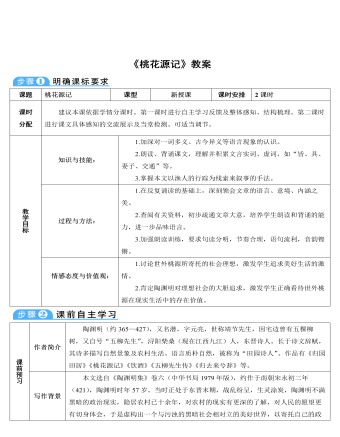
部编版语文八年级下册《桃花源记》教案
首先,我让学生结合书下注释,自行朗读课文。在读准字音的基础上,由老师带感情朗读,配合优美的乐曲,一下子便把学生带到课文的意境中,然后再由学生仿读,边读边体会,读中导,读中悟。接着,给学生自主学习的空间。我要求同学们凭借下面的注释,结合语境翻译课文,然后小组自主探究,最后小组提出疑难点,教师在班上引导学生解决,并把文言实词虚词归类。三、反复诵读,品味佳句,突破重难点。如果说前面的读是在为品做准备,那么真正的品就在学生对文章优美佳句的欣赏上,要求学生仔细品味自认为文中写得好的语句。这一环节我首先让学生自行找出自己喜爱的地方,然后说明喜爱的原因。这既是一种对课文的理解,又是一种知识的迁移。

《传承优秀传统文化》主题班会教案3篇
活动要求:1、 各班级务必要邀请一位老师(辅导员或导师),若导生在校,则可邀请导生到场观看。2、 各班级要根据自身情况,由班长、学委负责组织,深入把握该次主题活动精神所在,拟定好方案。并且务必在举行主题班会前提前知会秘书处和学习部的系负责人,及时通知他们主题班会开展的时间地点。3、 各班级的班干部要积极参与主题班会的各项组织工作,做好考勤、场地、议程安排和讨论记录等工作。4、 活动过程注意时间,纪律等方面的控制。推荐活动时间为60分钟。5活动2天内,请各位班长将此计划书与总结书以电子版形式发到秘书处系负责人处.逾期不候.总结书的要求(400字以上):总结内容包括:总结本次主题班会的优缺点、以及工作建议等等。总结是主题班会的成果体现,请班级给予充分重视。班长签名:班会结束后2天内,请各位班长将此计划书与总结书以电子版形式发到秘书处系负责人处.逾期不候.
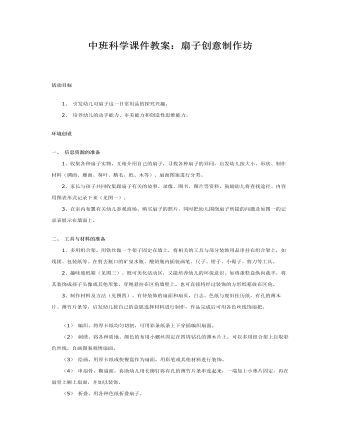
中班科学课件教案:扇子创意制作坊
2、培养幼儿的动手能力、审美能力和创造性思维能力。环境创设一、信息资源的准备1、收集各种扇子实物,互相介绍自己的扇子,寻找各种扇子的异同,启发幼儿按大小、形状、制作材料(绸面、藤面、葵叶、鹅毛、纸、木等)、扇面图案进行分类。2、家长与孩子共同收集跟扇子有关的故事、录像、图书、图片等资料,鼓励幼儿将查找途径、内容用图表形式记录下来(见图一)。3、在室内布置有关幼儿参观商场、购买扇子的照片,同时把幼儿围绕扇子所提的问题及如图一的记录表展示在墙面上。二、工具与材料的准备1、多用组合架。用铁丝做一个架子固定在墙上,将相关的工具与部分装饰用品串挂在组合架上,如线团、包装纸等。在剪去瓶口的矿泉水瓶、酸奶瓶内插装画笔、尺子、钳子、小锯子、剪刀等工具。2、趣味废纸箱(见图三)。既可美化活动区,又能培养幼儿的环保意识。如将蛋糕盒纵向裁半,将其装饰成孩子头像或其他形象,穿绳悬挂在区角墙壁上。也可直接将经过装饰的方形纸箱放在区角。3、制作材料及方法(见图四)。有待装饰的扇面和扇页,白志、色纸与废旧挂历纸,有孔的薄木片、薄竹片条等,启发幼儿按自己的意愿选择材料进行制作,作品完成后可用各色丝线饰扇把。

